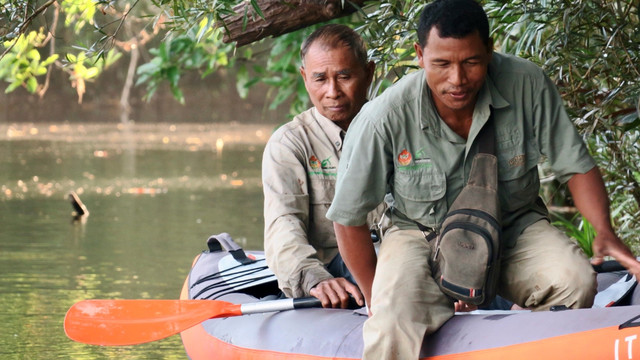Practical guide helps negotiators put equity at the heart of the new global biodiversity framework
Conservation efforts, while critical to reducing biodiversity loss, often fail to treat people fairly. This undermines the sustainability of these efforts and can further marginalise already vulnerable people. A new guide offers negotiators practical steps for embedding equity in the new global biodiversity framework.



Rural landscape in Bolivia. Conservation efforts must consider Indigenous Peoples and local communities, whose knowledge and experience could support conservation goals that are often overlooked (Photo: Bioversity International/Alfredo Camacho via Flickr, CC BY-NC-ND 2.0)
This week, negotiators from 196 countries under the Convention on Biological Diversity (CBD) are gathering virtually for the first formal negotiations of the year. Their main task? Progress discussions on the new Post-2020 Biodiversity Framework to be agreed at the 15th meeting of the CBD (COP 15) later this year in Kunming, China.
The global biodiversity framework (GBF) is a milestone in global agreements on biodiversity conservation, setting international ambition for the next decade. And the need to land a strong framework cannot be overstated, not least because none of the Aichi Targets from the previous 10-year biodiversity framework were met.
Negotiators are under pressure to work together to finalise a framework that truly delivers on its mission: to live in harmony with nature by 2050.
Calls for stronger focus on equity
The GBF failing to recognise equity was one of the thorny issues emerging from recent informal subsidiary body meetings. Various country statements and major stakeholder groups highlighted that equity must be central to efforts to reverse biodiversity loss.
Conservation efforts, such as restricting access to protected areas, can come at the expense of Indigenous Peoples and local communities through a loss of land, livelihoods and identity. These groups offer substantial knowledge, skills and experience to support conservation goals that are often overlooked.
Yet the current draft GBF falls short on emphasising the importance of equity for effective conservation efforts; a concern that will be raised again by parties during formal negotiations this month and next, and at the major mid-year negotiations in August.
Unless calls are met for the GBF to recognise the importance of equity in conservation, there remain doubts over whether it can truly deliver outcomes for both people and nature in the long term. Equity featured in the Aichi Targets and must be central to the GBF also.
New guide for CBD negotiators shines light on equity
In response to these calls, and based on research and our experience working with local partners at the frontline of conservation efforts, we have developed a practical guide for CBD negotiators on how to embed stronger recognition of equity in the GBF.
This guide is the first in a three-part series, with two further guides to follow in the coming weeks on other topics raised by negotiators.
This guide outlines what equity is and why it matters, why it should have a strong focus in the GBF, and how negotiators can push for equity to have more prominence.
The guide serves as an aid for negotiators looking to embed equity in the GBF as part of their national negotiation position. It outlines opportunities to promote equitable access to finance, strengthen intergenerational equity and uphold a rights-based approach in the GBF. And it proposes text edits on specific goals and targets, should negotiators want to use these during discussions.
For example, the guide provides advice on Target 2; a central component of the GBF which has been problematic for many. Its current framing in the GBF runs the risk of Indigenous Peoples and local communities being squeezed off their land, also known as ‘fortress conservation’, as countries seek to meet their commitment to protect 30% of the planet by 2030.
The guide provides alternative text for Target 2. It reintroduces equity and ensures the collective rights, governance systems, knowledge, innovations and practices of Indigenous Peoples and local communities are recognised and respected as countries seek to deliver on this target.
Equity should also be central to the negotiation process
While strengthening equity in the GBF is essential, upholding equity throughout the negotiation process itself is just as critical. Virtual negotiations and meetings are not accessible to everyone. Unless the negotiation process for the GBF is equitable and open to all, progressing substantive issues will be difficult.
We recently blogged about our survey of UNFCCC negotiators from the least developed countries who will be entering into the crunch climate negotiations this year. Of the 46 countries who responded, 90% agreed that poor internet accessibility and internet quality affected their ability to participate in virtual meetings.
Some delegates were unable to attend any virtual meetings or had to withdraw from UNFCCC committees altogether. CBD negotiators and representatives from major stakeholder holder groups face similar challenges.
CBD negotiators must be aware of the limitations of virtual negotiations and push to ensure all parties and stakeholders can fully engage in negotiation meetings, whether in-person, virtual or a hybrid.
Building synergies for equitable outcomes
The final negotiations in Kunming must seize the opportunity to place equity at the core of the GBF − to bring it in line with other international and regional agreements, including the Paris Agreement on climate change and the Sustainable Development Goals.
All three agreements need to work alongside each other to address the climate, nature and poverty crises. To do so, equity must be front and centre.





